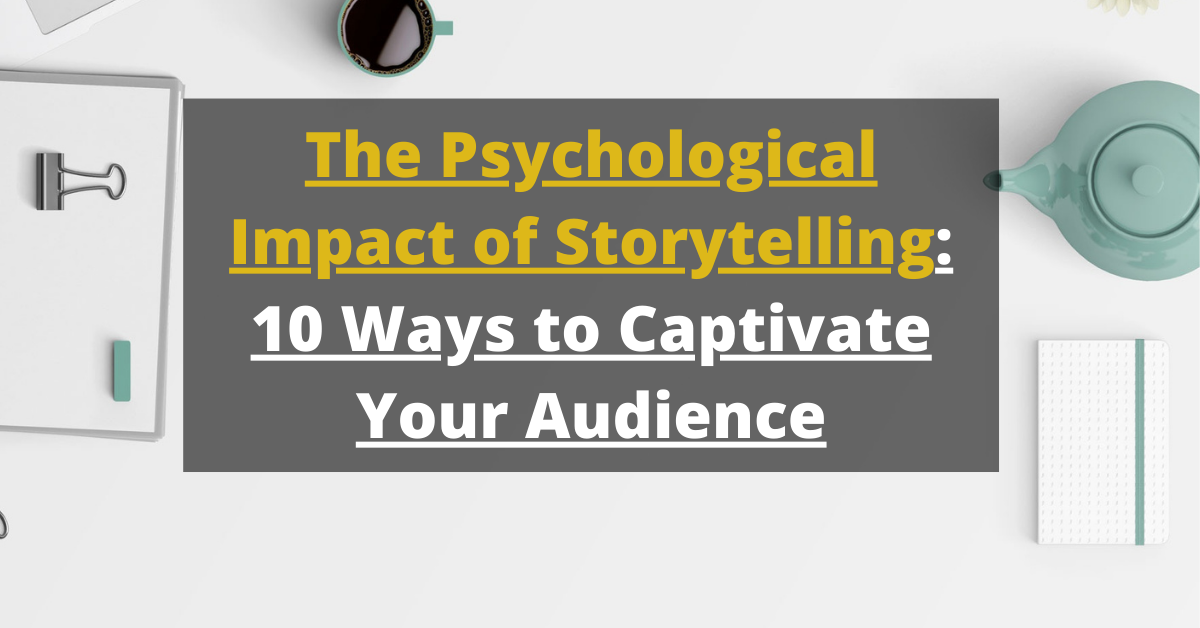Psychological Impact of Storytelling
In the realm of communication, stories have always held a unique power. They are more than just sequences of events; they are windows into the human experience, revealing emotions, ideas, and universal truths. From ancient myths told around campfires to modern-day novels and movies, storytelling has consistently captured our attention and engaged our minds. But what is it about stories that makes them so captivating? Let’s delve into the psychological impact of storytelling and uncover how it truly captures and influences its audience.

Listen to the Podcast Episode
1. The Innate Connection: Stories and Human Nature

At its core, storytelling taps into something deeply ingrained in human nature – the need to connect and make sense of the world. From an evolutionary perspective, stories were vital for passing down knowledge, teaching lessons, and building social bonds within communities. Our brains are wired to process and remember information better when it’s presented in a narrative form. This is because stories activate multiple parts of the brain, including those responsible for sensory experiences, emotions, and motor skills.
2. The Power of Empathy: Living Through Others

One of the most remarkable aspects of storytelling is its ability to evoke empathy. When we hear or read a story, our brains simulate the experiences of the characters, allowing us to understand their emotions, struggles, and motivations. This immersion triggers the release of oxytocin, often referred to as the “empathy hormone.” As a result, we form a deep emotional bond with the characters, connecting us to their journey on a profound level.
3. The Neurochemistry of Engagement: Dopamine Release

Have you ever been so engrossed in a story that you lost track of time? That’s likely due to the release of dopamine in your brain. Dopamine, often associated with pleasure and reward, is released when we encounter something novel and engaging. A well-crafted narrative with unexpected twists and turns keeps our brains hooked, making us crave the resolution that comes with the story’s conclusion
4. Influencing Thoughts and Behaviors: The Power of Persuasion

Storytelling isn’t just about captivating an audience; it’s also a potent tool for persuasion. When ideas are presented in a narrative form, they become more relatable and memorable. This is why advertisers often use storytelling to promote products and causes. By aligning a message with a compelling story, they tap into the psychological principles of identification and emotional resonance
5. Memories That Last: Storytelling and Recall

The human mind is inherently inclined to retain narratives more efficiently than standalone pieces of information.. This phenomenon is known as the “serial position effect.” We remember the beginning and end of a story (the primacy and recency effect), and we fill in the gaps with details from the narrative. This attribute has made storytelling a powerful tool for passing down cultural heritage and preserving historical events.
6. Escaping Reality: Transportation and Absorption

Engaging stories have the unique ability to transport us to different worlds and times, offering an escape from our daily lives. This concept, known as “narrative transportation,” involves becoming so absorbed in a story that our sense of reality fades away. It’s the reason why we can become emotionally invested in fictional worlds, empathizing with characters and experiencing their triumphs and tribulations as if they were our own.
7. The Cathartic Release: Emotional Healing Through Stories

Stories have the power to heal. When we encounter characters facing challenges similar to our own, it provides a sense of validation and catharsis. Through their struggles and eventual triumphs, we find solace and courage to confront our own difficulties. This therapeutic effect of storytelling is harnessed in various forms of narrative therapy, where individuals explore their emotions and experiences through storytelling.
8. Creating Lasting Impressions: Storytelling and Branding

Brands understand the impact of storytelling on human psychology. A well-crafted brand story can establish an emotional connection with consumers, transforming them into loyal advocates. By sharing the brand’s values, mission, and journey, companies can create a narrative that resonates, making the brand more relatable and memorable.
9. The Universality of Archetypes: Connecting Across Cultures

Certain story elements, known as archetypes, transcend cultural boundaries and resonate with people from different backgrounds. These universal symbols and themes tap into shared human experiences, making stories relatable on a global scale. Archetypes like the hero’s journey, the mentor, and the underdog are all part of the storytelling tapestry that binds humanity together.
10. Teaching Lessons Through Stories: Morality and Values

Throughout history, stories have been used to impart moral lessons and values. By presenting ethical dilemmas and their consequences, stories encourage reflection and critical thinking. This educational aspect of storytelling helps shape individuals’ understanding of right and wrong, fostering empathy and ethical behavior.
Conclusion

In conclusion, storytelling is an art form that transcends time and culture, leaving an indelible mark on human psychology. Its ability to evoke emotions, foster empathy, and influence behavior underscores its significance in communication and connection. From the earliest tales shared around fires to the digital narratives of today, storytelling continues to be a powerful force that captivates, educates, and shapes our collective consciousness.
Frequently Asked Questions:
Stories engage multiple parts of the brain, making information more memorable and relatable. This leads to better understanding and retention of messages.
Absolutely. Narrative therapy utilizes storytelling to help individuals explore and process their emotions, leading to healing and personal growth.
Post-purchase engagement fosters customer loyalty, encourages repeat business, and turns customers into brand advocates.
Brands create narratives that connect with consumers on an emotional level, building brand loyalty and advocacy.
Yes, storytelling can influence behavior by presenting relatable scenarios and ethical dilemmas that encourage reflection and empathy.
Want to Build Your Business on Instagram?
Other Links:
- Subscribe to my YouTube Channel: Miithyl Dave
- Subscribe to our Newsletter on Linkedin “Content Chemistry”: Miithyl Dave

